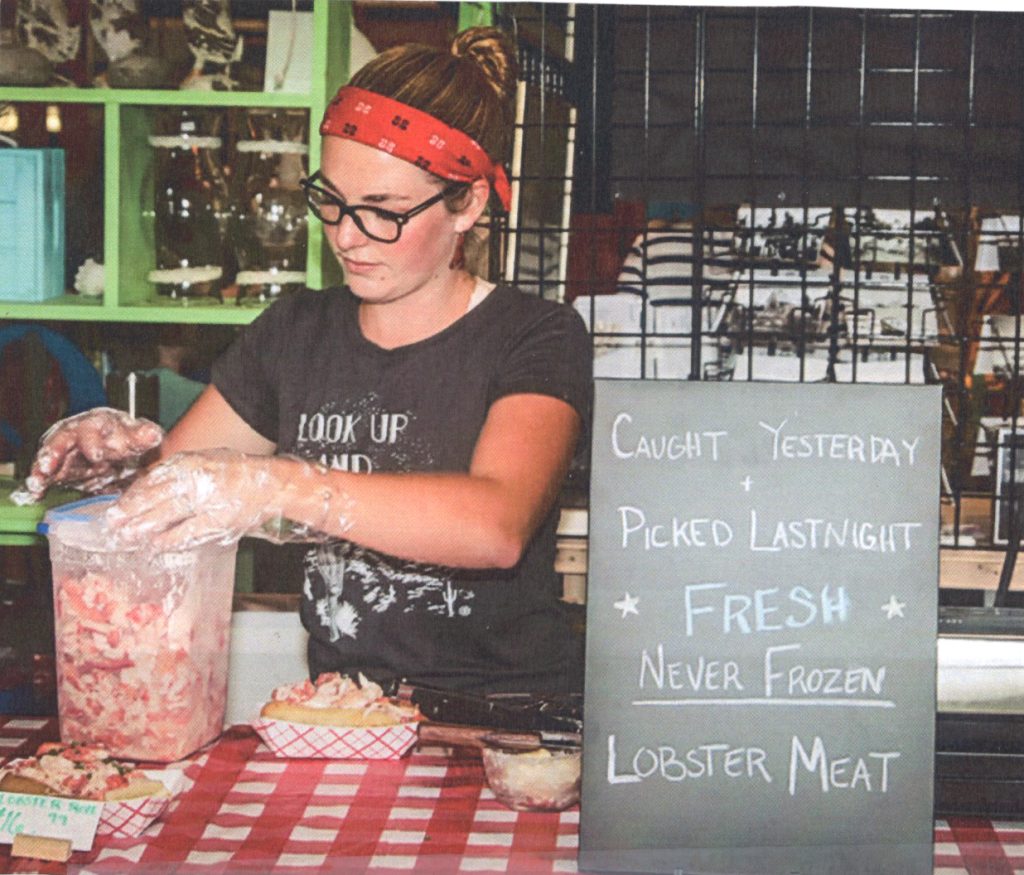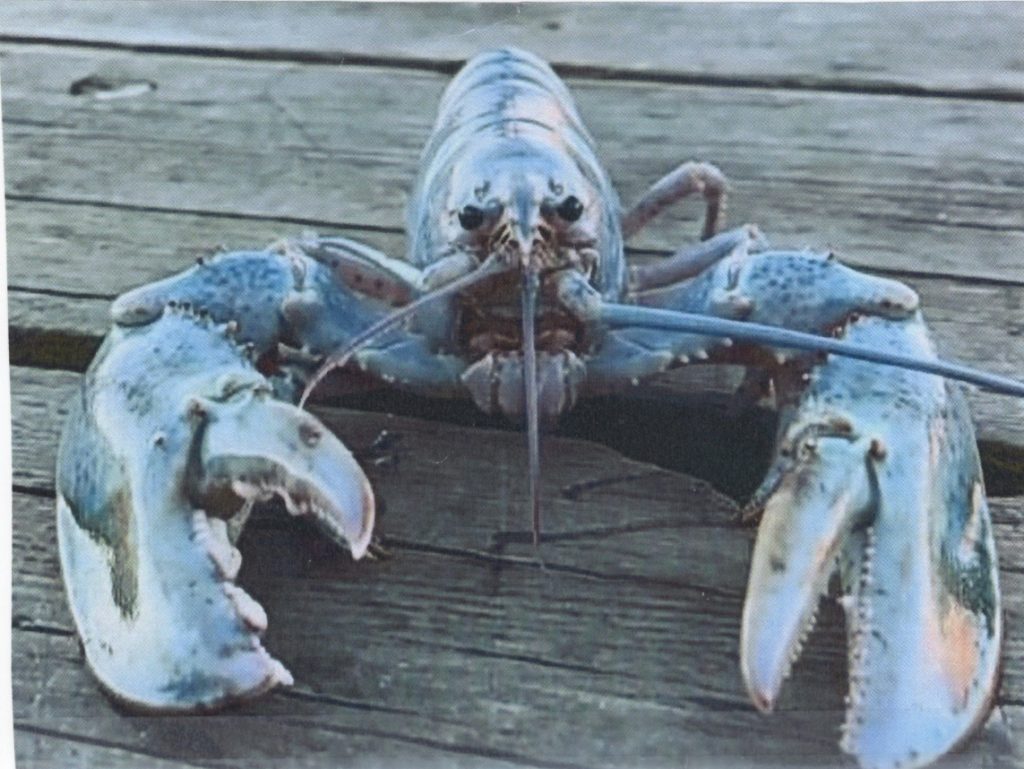
The Maine lobsters that are so popular around the Christmas and New Year’s holidays are caught mostly by two person crews, the lobsterman and his or her sternman. The lobsterman runs the boat, hauls in the traps and has the financial responsibilities of the venture – buying bait and keeping the boat operational. The sternman handles the contents of the traps, measures the lobsters and rebaits the traps. They start their day early, well before dawn, when they buy fresh bait for the day. When the sternman sorts through each trap, he or she tosses the shorts and also returns the oversize lobsters that are thought to be bigger producers. The sternman bands the claws of the keeper lobsters and they go into a crate to be sold.
Each boat has a limit in Maine of 800 traps or less. Some of the younger lobstermen work their way to 800 and have limits on the number of traps they can work with until they reach the age the State allows 800. The traps are connected, usually in a series of eight that are attached to a buoy with the lobsterman’s unique colors and patterns. When sorting through the traps, the sternman will toss back females with eggs or females notched by other lobstermen for having been a breeder. New bait goes into each emptied trap and when the series of eight traps are cleaned out and rebaited, they slide back in the water, one by one.

Back at the dock the dealer takes the crated keeper lobsters and weighs them. The lobsterman is paid according to what the going rate per pound is times the number of pounds caught. The sternman’s cut is 20% of what the lobsterman gets for the lobsters.
There are about 5900 licensed lobstermen in Maine. In 2015 150 of them were over the age of 80. At the other end of the age spectrum, more children are starting the licensing process by putting in hours working mostly with family members. A student lobster and crab fishing license may be issued to a person who at the time of application is 8 years of age or older and under 23 years of age and who is attending a public day school. There is a long wait for a commercial lobster license and the student license circumvents the wait list.
Erin Henley started as a sternman for her father, Patrick Henley. She finished the apprentice program, graduated a year early from Mt. Desert High School and became a full-time lobsterman at 18. She now owns a 25-foot boat and expects to have it another year before upgrading to a bigger boat. Ignoring older lobstermens’ advice to go to school to prepare for an alternate future, she is counting on the availability of lobsters and the higher prices of recent times.
Sadie Samuels, 25, has been lobstering since she was 7. Of the over 5000 licenses issued in Maine in 2016, 434 went to women. Sadie’s yellow and green buoys identify the start of her traps in Penobscot Bay. Her sternman, Aaron Sekina, is often mistaken for the captain. Sadie and her sister sell lobsters and lobster rolls at the Belfast Farmers Market on Saturdays.
A young Swan’s Island lobsterman, Caleb MacDonald, now in his early twenties, started as a child working with family members and by the age of 21, had a permit to fish in federal waters, a new boat, all new gear, a new truck and a house of his own.
The youngest lobsterman issued a commercial license in Maine so far have been Colbath Warner and Jordan Drouin. At 16 and 17 they run a 32-foot diesel powered boat out of Cutler Harbor. Still in school, they fish from late spring through September after school and on weekends.
I spoke to the oldest person (101 years old) with a Maine commercial lobsterman’s license, Virginia Oliver. By the time we talked in November, the traps were out of the water and she and her son Max were finished until the spring. Ginny, as she likes to be called, started lobstering with her father when she was 8 years old. She married a lobsterman and worked for the company that bought the lobsters until the day she decided she had enough of working inside. She quit her job midday, went home and did some wash. When her husband came home and saw the wash he asked what happened to her job and that’s when he found out he had a new sternman.
In the years Ginny has been lobstering she usually takes home a small–pound and a quarter-size lobster once or twice a week, boils it and after separating the lobster from the shell, makes her favorite lobster meal – the lobster roll. She likes the bun toasted with butter and just a little Hellmans on the lobster.
Retirement is not in Ginny’s vocabulary unless you’re sick. When someone asked about her 78 year old son Max, what if he wanted to retire, she said he’d have to have something wrong with him to retire. She feels working and living independently as she does, may be factors that have led her to live a longer life. Her philosophy is that it’s better to do more for yourself when you get older. She has noticed that older people who work longer seem to be happier.
Asked whether she and her son are getting as many lobsters as they did 5 or 10 years ago, she said they were not and she attributes that to more people fishing. Asked about whether the new regulations would affect their lobstering, she said they would.
There isn’t a lot of disagreement about the difference between Canadian and Maine lobsters. Although they belong to the same species, the Maine lobster grows up in a warmer part of the ocean, causing the meat to be tenderer and taste better than the harder shelled Canadian lobsters found in colder waters. The colder temperatures make Canadian lobsters’ shells denser and harder to crack open. These Canadian lobsters are the ones you usually find in the supermarkets. Their harder shells make them easier to transport without breakage and sell at prices that allow the big markets to offer lobster at lower prices.

How did the McDonald’s lobster rolls compare with what most of us consider authentic lobster rolls we find at lobster shacks when traveling in coastal New England? The author of a book on New England seafood shack rolls tried the McDonald’s version of the lobster roll and said he was pleasantly surprised – it was better than he expected, even though they use frozen lobster meat.
The boats lobstermen use to get their traps placed and then pulled out are very varied, ranging from small open boats to more substantial ocean going vessels. The old time description of a lobster boat was the “pickup truck of the Maine coast.” The traditional lobster boat, still built in Maine on Mount Desert Island, is a design more than a rigid description of its elements. Most downeast style boats share seaworthy hulls with deep keels.
A semi-displacement vessel with a sweeping sheer that comes aft, has been a style used by recreational boat designers since naval architect Bruce King designed the downeast style Hinckley Picnic Boat in 1994. Up to that time King had designed and was known for his line of stylish large sailboats. Hinckley saw a future in its new express cruiser and trademarked the name Picnic Boat, which has been described as the perfect balance of beauty, craftsmanship and performance.
The other takeoff that was very popular from the workboat profile was the Mainship Pilot model. The 30 foot Pilot came out in 1999. It was equipped and priced for the average family and was produced until 2008.
Recently a blue lobster was caught in Maine and although there are no rules about keeping unique colored lobsters, the lobsterman decided it should be seen by others and was planning to donate it to an aquarium in Maine. It was said to be a one in a million color for a lobster.
To save the right whale population which has been dying off, federal regulators have decided to close a large area off the coast of Maine where they think the whales are getting entangled with lobstermens’ trap lines. They will only allow lobstermen to fish the area if they use the ropeless technology where the traps have a sensor that the lobsterman’s smartphone can access and call the trap to the surface. The traps are supposed to be strung together with what the regulators call “weak lines” that will break if the right whale gets caught in it.
It’s hard to believe that the colonists thought so little of lobsters they fed them to prisoners and the prisoners complained if they got lobster too often. It was only when New York City restaurants started serving lobster that their status improved and they worked their way up from jail food to luxury dining experiences.
